20 12 10: CERN antihydrogen research scoops top physics breakthrough award
![[IMAGE]](http://public.web.cern.ch/public/features/1012_ALPHA.jpg)
Untrapped antihydrogen atoms annihilating on the inner surface of the ALPHA trap.
Two international teams of collaborators who conduct antimatter research at CERN have been awarded the 2010 Breakthrough of the Year by the British magazine Physics World. The two experiments, ALPHA and ASACUSA, were selected for developing techniques that will allow researchers to study matter's elusive twin — antimatter.
CERN has a long history of antimatter research; the first antihydrogen atoms were produced at CERN in 1995. However, the fleeting existence of antiatoms meant that they could not be used for further studies: each one existed for only about 40 billionths of a second and travelled at the speed of light before annihilating with ordinary matter.
In November the ALPHA collaboration announced that it had successfully trapped 38 antihydrogen atoms for around 170ms — long enough to potentially study their properties. Weeks later the ASACUSA group announced that they had made a major breakthrough towards creating a beam of antihydrogen suitable for spectroscopic studies. These two techniques open the door to future studies of antimatter. The procedures used to form antihydrogen build on techniques developed by a third antihydrogen experiment at CERN, ATRAP, which pioneered trapping techniques in the 1990s, and is also working on trapping antihydrogen.
Antimatter research was not the only appearance CERN made in Physics World’s top 10: the first LHC collisions also made the list, coming in at number 10.
More information
- Physics World: Physics World reveals its top 10 breakthroughs for 2010
- Press release: CERN experiment makes progress towards antihydrogen beams
- Press release: Antimatter atoms produced and trapped at CERN
- Video: Interview with Jeffrey Hangst (ALPHA collaboration)
- CERN website: The true story of antimatter
- CERN website: AD - The antiproton decelerator
- Video: 2010: A year at CERN
26.11.10: LHC experiments bring new insight into primordial universe
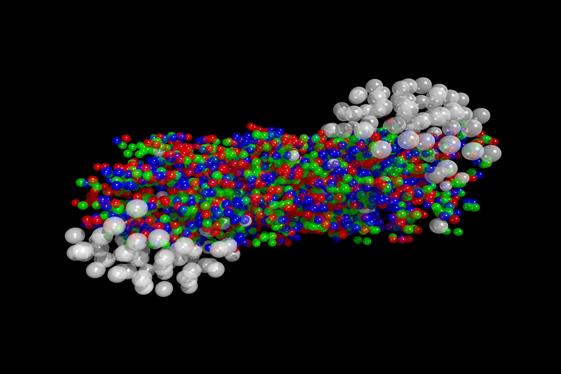
Snapshot of two colliding lead ions just after impact (simulation).
After less than three weeks of heavy-ion running, the three experiments studying lead ion collisions at the LHC have already brought new insight into matter as it would have existed in the very first instants of the Universe’s life. The ALICE experiment, which is optimised for the study of heavy ions, published two papers just a few days after the start of lead-ion running. Now, the first direct observation of a phenomenon known as jet quenching has been made by both the ATLAS and CMS collaborations. This result is reported in a paper from the ATLAS collaboration accepted for publication yesterday in the scientific journal Physical Review Letters. A CMS paper will follow shortly, and results from all of the experiments will be presented at a seminar on Thursday 2 December at CERN. Data taking with ions continues to 6 December.
More information
17.11.10: Antimatter atoms produced and trapped at CERN
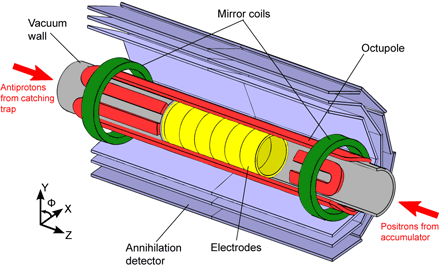
A diagram showing the region where antihydrogen atoms are synthesized and trapped in the ALPHA apparatus. IMAGE: Nature, copyright Macmillan Magazines 2010.
The ALPHA experiment at CERN has taken an important step forward in developing techniques to understand one of the Universe’s open questions: is there a difference between matter and antimatter? In a paper published in Nature today, the collaboration shows that it has successfully produced and trapped atoms of antihydrogen. This development opens the path to new ways of making detailed measurements of antihydrogen, which will in turn allow scientists to compare matter and antimatter.
Antimatter – or the lack of it – remains one of the biggest mysteries of science. Matter and its counterpart are identical except for opposite charge, and they annihilate when they meet. At the Big Bang, matter and antimatter should have been produced in equal amounts. However, we know that our world is made up of matter: antimatter seems to have disappeared. To find out what has happened to it, scientists employ a range of methods to investigate whether a tiny difference in the properties of matter and antimatter could point towards an explanation.
More information
08.11.10: CERN completes transition to lead-ion running at the LHC
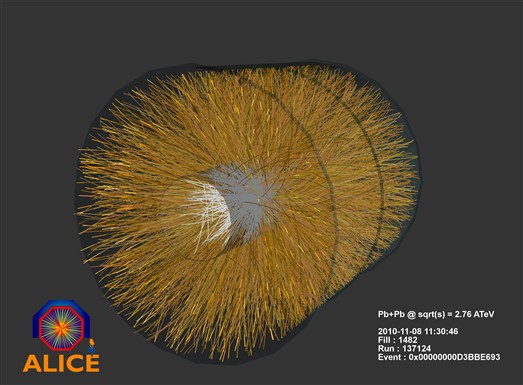
An image of one of the first lead-ion collisions seen by the ALICE experiment on 7 November.
Four days is all it took for the LHC operations team at CERN to complete the transition from protons to lead ions in the LHC. After extracting the final proton beam of 2010 on 4 November, commissioning the lead-ion beam was underway by early afternoon. First collisions were recorded at 00:30 CET on 7 November, and stable running conditions marked the start of physics with heavy ions at 11:20 CET today.
“The speed of the transition to lead ions is a sign of the maturity of the LHC,” said CERN Director General Rolf Heuer. “The machine is running like clockwork after just a few months of routine operation.”
More information
04.11.10: The LHC enters a new phase
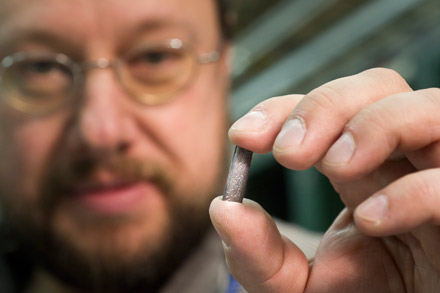
Detlef Kuchler, a physicist in CERN's Beams department, holds a piece of the lead source material used to create heavy ions for the LHC. Photo: M. Brice / CERN More photos »
LHC proton running for 2010 came to a successful conclusion at 08:00 CET on 4 November. All of the objectives for the LHC's first year of proton physics have been achieved and new ground has been explored. Now the LHC is moving on to a different mode of operation in which lead ions will be accelerated and brought into collision in the machine for the first time. This opens up an entirely new avenue of exploration for the LHC programme, probing matter as it would have been in the first instants of the Universe’s existence.
One of the main objectives for lead-ion running is to produce tiny quantities of such matter, which is known as quark-gluon Plasma, and to study its evolution into the kind of matter that makes up the Universe today. This exploration will shed further light on the properties of the strong interaction, which binds Nature’s fundamental particles, called quarks, into bigger objects such as protons and neutrons, which are themselves the building blocks of the atomic elements.
More information
03.11.10: Happy Birthday, François de Rose
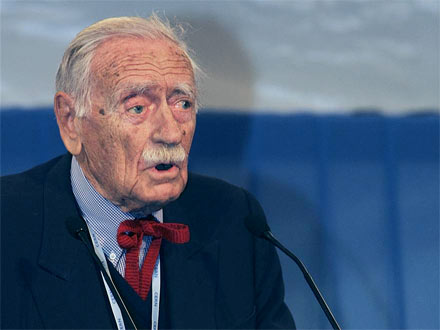
François de Rose, Ambassador for France and one of CERN's founding fathers, today celebrates his 100th birthday.
After the second world war, François de Rose represented France on the Atomic Energy Commission, a body set up by the fledgling United Nations Organisation in New York. There he met some of the great physicists of the day, who were convinced that restoring Europe's fundamental research infrastructure would be one of the motors of its reconstruction. As a diplomat, he took up the physicists' cause and helped them advocate to European governments the creation of Europe's first fundamental research facility. CERN was founded in 1954 and François de Rose was Council President from 1958 to 1960. His term of office notably saw the extension of the CERN site into French territory.
François de Rose has often said that his role in the creation of this Laboratory is the proudest achievement of his career. Today, we at CERN are proud and honoured to wish him a happy birthday and thank him for his commitment to fundamental research.
Happy birthday to you !
More information
14.10.10: LHC protons 2010: mission accomplished
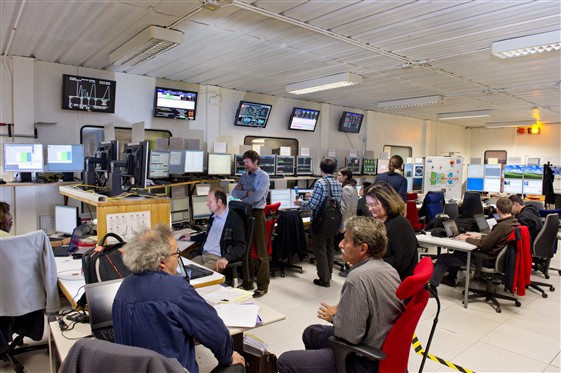
Physicists gathering proton collision data in the LHCb experiment's control room More photos »
The LHC today reached its target luminosity for 2010 - 1032/cm2/s. This is a measure of the proton-proton collision rate in the experiments.
This is a signifcant milestone in gathering the amount of data expected by the end of 2011 - called one inverse femtobarn by physicists. With that amount of data there will be a good chance of seeing new physics in the LHC's current energy range.
The remainder of this year’s proton running will be devoted to obtaining as much data as possible before switching to lead ions collisions in November.